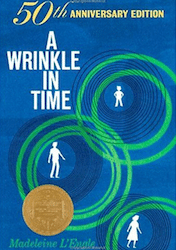For there is many a small betrayal in the mind,
a shrug that lets the fragile sequence break
sending with shouts the horrible errors of childhood
storming out to play through the broken dike.
from A Ritual to Read to Each Other, by William Stafford
The dike in the galaxy has broken. Horrible errors are storming through on dark and stormy nights, along with other-worldly women. Our world is more fragile than we thought. Welcome to Madeleine L’Engle’s classic A Wrinkle in Time.
Last year I taught a workshop with this book as our only text. Published in 1962, it’s about a father who is missing — probably on another planet — and the family who is left behind. It is up to our hero, Meg, to save the day.
The story of how this book came to be is almost as strange as the story itself. L’Engle was struggling with her faith and found refuge in science rather than in theology. She had been reading Albert Einstein, Max Planck, and Werner Heisenberg, and on a ten-week cross-country camping trip the names Mrs Whatsit, Mrs Who, and Mrs Which popped into her head.
The book was rejected by somewhere between twenty-five and forty publishers (L’Engle did not always give the same figure). No one knew what to do with it. Wasn’t it too science-y? Why does an alien creature burst into Psalm? Who would want to read about a female hero who isn’t a princess and is good at math?
We have John Farrar to thank for taking a chance on the book. But even he came to it with a bit of serendipity — after a tea party. Here’s how The Writer’s Almanac tells the story:
That year, her mother visited for Christmas, and L’Engle hosted a tea party for her mother’s old friends. One of those friends was in a writing group with John Farrar of the publishing house Farrar, Strauss, & Giroux. They didn’t publish young adult fiction, but the woman insisted that L’Engle meet Farrar and at least show him the manuscript.”
He accepted it, and A Wrinkle in Time won the Newbery Medal in 1963. It has never been out of print and was turned into a feature film in 2018. L’Engle added a clause to her contract that the publisher retained all standard rights, in perpetuity, except in the Andromeda Galaxy.
A Wrinkle in Time is not a tidy book. It begins with the biggest writing cliché of all time and ends in a gust of wind that steals Mrs Whatsit’s final words. In between, there is cocoa, a tesseract, and the power of love. I like to think of the story as a hurricane: It barrels in and forces you to reckon with it, and you can’t walk away unchanged.
Here’s a schedule for reading and discussing:
October 14: chapters 1-4
October 21: chapters 5-8
October 28: chapters 9-12
September’s Pages
Poetry
Neruda’s Memoirs, Maureen Doallas
Still Pilgrim, Angela Alaimo O’Donnell (Rereading to practice sonnets)
Picture Books and Early Readers
Where the Buffaloes Begin, by Olaf Baker, illus. Stephen Gammell
The Little Island, Margaret Wise Brown, illus. Leonard Weisgard
Ordinary Things: Poems from a Walk in Early Spring, Ralph Fletcher
Middle Grade and YA
A Wrinkle in Time, Madeleine L’Engle
Just Beyond: The Scare School, R.L.Stine, illus. Nichole Matthews, Kelly Matthews (Join us for a spooky Children’s Book Club on Friday, October 9!)
Grownups
Tristan and Isolde, as told by M. Joseph Bedier, transl. Hilaire Belloc
Flannery O’Connor: Collected Works, Flannery O’Connor (sliced & diced, focused on her letters)
How Long ‘Til Black Future Month?, N.K. Jemisin (short stories, mostly SF)
Made Progress
Jane on the Brain: Exploring the science of social intelligence with Jane Austen, Wendy Jones
Photo by Giuseppe Milo, Creative Commons, via Flickr. Post by Megan Willome.
Browse more from A Ritual to Read to Each Other
“Megan Willome’s The Joy of Poetry is not a long book, but it took me longer to read than I expected, because I kept stopping to savor poems and passages, to make note of books mentioned, and to compare Willome’s journey into poetry to my own. The book is many things. An unpretentious, funny, and poignant memoir. A defense of poetry, a response to literature that has touched her life, and a manual on how to write poetry. It’s also the story of a daughter who loses her mother to cancer. The author links these things into a narrative much like that of a novel. I loved this book. As soon as I finished, I began reading it again.”
—David Lee Garrison, author of Playing Bach in the D. C. Metro
- Perspective: The Two, The Only: Calvin and Hobbes - December 16, 2022
- Children’s Book Club: A Very Haunted Christmas - December 9, 2022
- By Heart: ‘The night is darkening round me’ by Emily Brontë - December 2, 2022



Glynn says
‘A Wrinkle in Time’ endures, as it should.
September Reading
Fiction
A Man by Keiichiro Hirano
The Old American Artist by Felipe Adan Lerma
The Smell of Cedar by River Dixon
Hunger by Knut Hamsun
Romance
Engaging Mr. Darcy by Rachel John
Message in a Bottle by Beth Wiseman
Risking It All for Love by Kimberley Monpetit
Christmas Dreams and Santa Schemes by Barbara Rohr
Snowed In on Main Street by Kasey Stockton
Mystery
Fire in the Barley by Roger Longrigg
All the Devils Are Here by Louise Penny
Make Haste Slowly by Amy Rognlie
The Auschwitz Detective by Jonathan Dunsky
The Phantom Murder by Roy Lewis
Corrupted by Simon Michael
Poetry
30 Poems to Memorize (Before It’s Too Late), edited by David Kern
She Needs That Edge by Paul Brookes
The Headpoke and Firewedding by Paul Brookes
A World Where by Paul Brookes
Non-fiction / Memoir
Borges and Me by Jay Parini
The Boy Between Worlds by Annejet Van Der Zijl
Film script
Modern Art by Laurence Fuller
Faith
On Wealth and Poverty by St. John Chrysostom
Megan Willome says
Agreed, Glynn.
I look forward to you sharing your reading list each month. Thanks for being so faithful to do that.
Sandra Heska King says
Oooohhh… How fun to revisit this “sparkler.”
Slicing and dicing several this month, including The Poets Guide to the Birds edited by Judith Kitchen and Ted Kooser. Published by Anhinga (!) Press.
Megan Willome says
Sandy, that sounds really interesting. I have really come to appreciate Ted Kooser’s editorial skills as he chooses poems for American Life in Poetry, so I expect his touch is evident in this book too. Plus, I love bird poems.
Sandra Fox Murphy says
Sandy … The Poets Guide to the Birds intrigues me! Adding it to my list. I agree with Megan … bird poems always have a certain movement to them, usually graceful. Sometimes startling.
Megan Willome says
Sandra, if a poem has a bird in it, you can bet I’m going to pay close attention. And then I go look it up on the Cornell Ornithology website, allaboutbirds.org.
Megan Willome says
Just saw that N.K. Jemisin is one of this year’s MacArthur Fellows. Let’s hear it for speculative fiction!